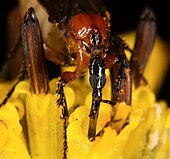en
names in breadcrumbs



Plecia is a genus of March flies (Bibionidae) comprising many species, both extant and fossilised.
Many fossil species have been assigned to Plecia with ages dating from the Cretaceous (Campanian) through the early Pleistocene (Gelasian):[6]
Revision of the Bibionidae fossil record from the Oligocene of Germany by Skartveit and Wedmann (2021) included the redescription of a number of Plecia species.[7]
 Close-up of head, P. nearctica
Close-up of head, P. nearctica Plecia is a genus of March flies (Bibionidae) comprising many species, both extant and fossilised.